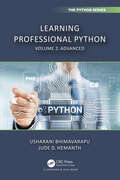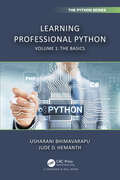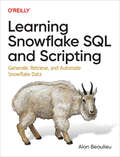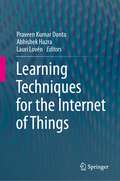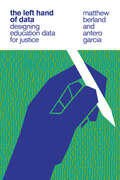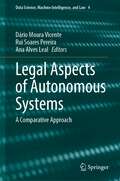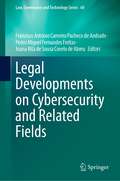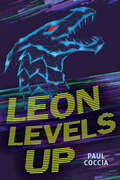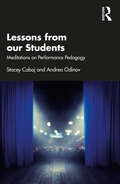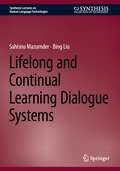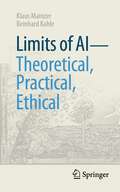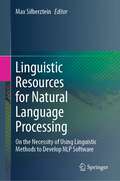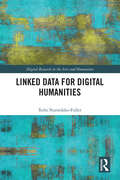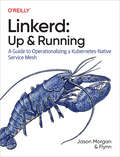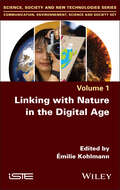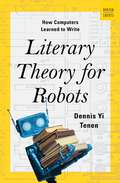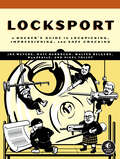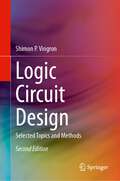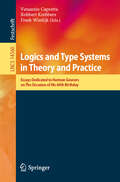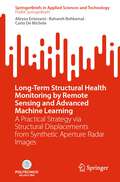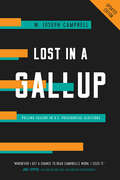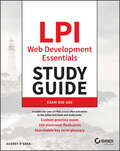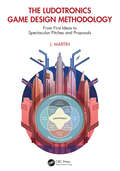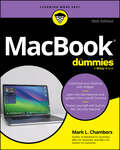- Table View
- List View
Learning Professional Python: Volume 2: Advanced (Chapman & Hall/CRC The Python Series)
by Usharani Bhimavarapu Jude D. HemanthVolume 2 of Learning Professional Python is a resource for students who want to learn Python even if they don’t have any programming knowledge and for teachers who want a comprehensive introduction to Python to use with their students. This book helps the students achieve their dream job in the IT Industry and teaches the students in an easy, understandable manner while strengthening coding skills. Learning Professional Python: Volume 2 Objectives Become familiar with the features of Python programming language Introduce the object-oriented programming concepts Discover how to write Python code by following the object-oriented programming concepts Become comfortable with concepts such as classes, objects, inheritance, dynamic dispatch, interfaces, and packages Learn the Python generics and collections Develop exception handling and the multithreaded applications Design graphical user interface (GUI) applications
Learning Professional Python: Volume 1: The Basics (Chapman & Hall/CRC The Python Series)
by Usharani Bhimavarapu Jude D. HemanthVolume 1 of Learning Professional Python is a resource for students who want to learn Python even if they don’t have any programming knowledge and for teachers who want a comprehensive introduction to Python to use with their students. This book helps the students achieve their dream job in IT Industry and teaches the students in an easy, understandable manner while strengthening coding skills. Learning Professional Python: Volume 1 Objectives Become familiar with the features of Python programming language Introduce the object-oriented programming concepts Discover how to write Python code by following the object-oriented programming concepts Become comfortable with concepts such as classes, objects, inheritance, dynamic dispatch, interfaces, and packages Learn the Python generics and collections Develop exception handling and the multithreaded applications Design graphical user interface (GUI) applications
Learning Snowflake SQL and Scripting
by Alan BeaulieuTo help you on the path to becoming a Snowflake pro, this concise yet comprehensive guide reviews fundamentals and best practices for Snowflake's SQL and Scripting languages. Developers and data professionals will learn how to generate, modify, and query data in the Snowflake relational database management system as well as how to apply analytic functions for reporting.Author Alan Beaulieu also shows you how to create scripts, stored functions, and stored procedures to return data sets using Snowflake Scripting. This book is ideal whether you're new to databases and need to run queries or reports against a Snowflake database, or transitioning from databases such as Oracle, SQL Server, or MySQL to cloud-based platforms.With this book, you will:Generate and modify Snowflake data using Insert, Update, DeleteQuery data in Snowflake using Select, including joining multiple tables, using subqueries, and groupingApply analytic functions for performing subtotals, grand totals, row comparisons, and other reporting functionalityBuild scripts combining SQL statements with looping, if-then-else, and exception handlingLearn how to build stored procedures and functionsUse stored procedures to return data sets
Learning Techniques for the Internet of Things
by Praveen Kumar Donta Abhishek Hazra Lauri LovénThe book is structured into thirteen chapters; each comes with its own dedicated contributions and future research directions. Chapter 1 introduces IoT and the use of Edge computing, particularly cloud computing, and mobile edge computing. This chapter also mentions the use of edge computing in various real-time applications such as healthcare, manufacturing, agriculture, and transportation. Chapter 2 motivates mathematical modeling for federated learning systems with respect to IoT and its applications. Further Chapter 3 extends the discussion of federated learning for IoT, which has emerged as a privacy-preserving distributed machine learning approach. Chapter 4 provides various machine learning techniques in Industrial IoT to deliver rapid and accurate data analysis, essential for enhancing production quality, sustainability, and safety. Chapter discusses the potential role of data-driven technologies, such as Artificial Intelligence, Machine Learning, and Deep Learning, focuses on their integration with IoT communication technologies. Chapter 6 presents the requirements and challenges to realize IoT deployments in smart cities, including sensing infrastructure, Artificial Intelligence, computing platforms, and enabling communications technologies such as 5G networks. To highlight these challenges in practice, the chapter also presents a real-world case study of a city-scale deployment of IoT air quality monitoring within Helsinki city. Chapter 7 uses digital twins within smart cities to enhance economic progress and facilitate prompt decision-making regarding situational awareness. Chapter 8 provides insights into using Multi-Objective reinforcement learning in future IoT networks, especially for an efficient decision-making system. Chapter 9 offers a comprehensive review of intelligent inference approaches, with a specific emphasis on reducing inference time and minimizing transmitted bandwidth between IoT devices and the cloud. Chapter 10 summarizes the applications of deep learning models in various IoT fields. This chapter also presents an in-depth study of these techniques to examine new horizons of applications of deep learning models in different areas of IoT. Chapter 11 explores the integration of Quantum Key Distribution (QKD) into IoT systems. It delves into the potential benefits, challenges, and practical considerations of incorporating QKD into IoT networks. In chapter 12, a comprehensive overview regarding the current state of quantum IoT in the context of smart healthcare is presented, along with its applications, benefits, challenges, and prospects for the future. Chapter 13 proposes a blockchain-based architecture for securing and managing IoT data in intelligent transport systems, offering advantages like immutability, decentralization, and enhanced security.
The Left Hand of Data: Designing Education Data for Justice
by Matthew Berland Antero GarciaA speculative framework that imagines how we can use education data to promote play, creativity, and social justice over normativity and conformity.Educational analytics tend toward aggregation, asking what a &“normative&” learner does. In The Left Hand of Data, educational researchers Matthew Berland and Antero Garcia start from a different assumption—that outliers are, and must be treated as, valued individuals. Berland and Garcia argue that the aim of analytics should not be about enforcing and entrenching norms but about using data science to break new ground and enable play and creativity. From this speculative vantage point, they ask how we can go about living alongside data in a better way, in a more just way, while also building on the existing technologies and our knowledge of the present.The Left Hand of Data explores the many ways in which we use data to shape the possible futures of young people—in schools, in informal learning environments, in colleges, in libraries, and with educational games. It considers the processes by which students are sorted, labeled, categorized, and intervened upon using the bevy of data extracted and collected from individuals and groups, anonymously or identifiably. When, how, and with what biases are these data collected and utilized? What decisions must educational researchers make around data in an era of high-stakes assessment, surveillance, and rising inequities tied to race, class, gender, and other intersectional factors? How are these complex considerations around data changing in the rapidly evolving world of machine learning, AI, and emerging fields of educational data science? The surprising answers the authors discover in their research make clear that we do not need to wait for a hazy tomorrow to do better today.
Legal Aspects of Autonomous Systems: A Comparative Approach (Data Science, Machine Intelligence, and Law #4)
by Dário Moura Vicente Rui Soares Pereira Ana Alves LealAs computational power, the volume of available data, IT systems’ autonomy, and the human-like capabilities of machines increase, robots and AI systems have substantial and growing implications for the law and raise a host of challenges to current legal doctrines. The main question to be answered is whether the foundations and general principles of private law and criminal law offer a functional and adaptive legal framework for the “autonomous systems” phenomena.The main purpose of this book is to identify and explore possible trajectories for the development of civil and criminal liability; for our understanding of the attribution link to autonomous systems; and, in particular, for the punishment of unlawful conduct in connection with their operation. AI decision-making processes – including judicial sentencing – also warrant close attention in this regard.Since AI is moving faster than the process of regulatory recalibration, this book provides valuable insights on its redesign and on the harmonization, at the European level, of the current regulatory frameworks, in order to keep pace with technological changes.Providing a broader and more comprehensive picture of the legal challenges posed by autonomous systems, this book covers a wide range of topics, including the regulation of autonomous vehicles, data protection and governance, personality rights, intellectual property, corporate governance, and contract conclusion and termination issues arising from automated decisions, blockchain technology and AI applications, particularly in the banking and finance sectors.The authors are legal experts from around the world with extensive academic and/or practical experience in these areas.
Legal Developments on Cybersecurity and Related Fields (Law, Governance and Technology Series #60)
by Francisco António Carneiro Pacheco de Andrade Pedro Miguel Fernandes Freitas Joana Rita de Sousa Covelo de AbreuThis book presents a fresh approach to cybersecurity issues, seeking not only to analyze the legal landscape of the European Union and its Member States, but to do so in an interdisciplinary manner, involving scholars from diverse backgrounds – ranging from legal experts to ICT and engineering professionals.Cybersecurity requirements must be understood in a broader context, encompassing not just conventional aspects, but also emerging topics. This can only be achieved through an interdisciplinary approach. Indeed, cybersecurity should be consistently considered in relation to cybercrime and/or cyber defense, while examining it through the lens of specific domains that are intertwined with various legal fields. Moreover, it is crucial to uphold ethical standards and safeguard fundamental rights, particularly regarding personal data protection.By adopting this comprehensive perspective, the significance of cybersecurity in the exercise of public authority becomes apparent. It also plays an essential role in upholding the fundamental values of both individual Member States and the EU as a whole, such as the rule of law. Moreover, it fosters trust, transparency, and effectiveness in market relations and public administration interactions.In turn, the book draws on the expertise of its authors to provide insights into ICT components and technologies. Understanding these elements holistically is essential to viewing every "cyber" phenomenon from a legal standpoint. In addition to the holistic and interdisciplinary approach it presents, the book offers a captivating exploration of cybersecurity and an engaging read for anyone interested in the field.
Leon Levels Up (Orca Currents)
by Paul CocciaIn the real world, Leon isn’t built to be a hero, but he must become one when he gets trapped in a cutting-edge virtual-reality game. Twelve-year-old Leon loves video games. When he plays, he feels confident and amazing for just a little while. The rest of the time he feels like a loser. So Leon is shocked when Nico, the coolest kid ever and the son of a video-game developer, invites him over to test out the newest game at his dad’s high-tech lab. To play, they must submerge themselves in giant tanks filled with nanobots, which are programmed to interact with the players and form the physical gaming world. It sounds perfectly safe. But a glitch causes the tiny robots to start behaving oddly, putting the boys in real-life danger. Now it's up to Leon to slay a dragon, to beat the game and save Nico and himself...before the timer runs out.
Lessons from our Students: Meditations on Performance Pedagogy
by Stacey Cabaj Andrea OdinovLessons from our Students: Meditations on Performance Pedagogy is a collection of thirty short personal case studies about pedagogical issues that arise in theater classrooms and rehearsals. Teaching in the acting and performance classroom is rapidly changing in the early 2020s. In the wake of the global pandemic, online education, massive trauma, and a social justice revolution, educators are seeking wisdom, clarity, and reassurance about their pedagogy. The authors speak to the current moment and the unique challenges of teaching theater by presenting a personal, practical, and authentic expression of vulnerability, humanity, and artistry as teachers. Through thirty personal meditations, the authors pose reflective questions and discussion prompts that evaluate the craft of teaching theater, issues that arise, and ideas about how to respond with vision and integrity. Accompanying exercises invite readers to reflect on their own teaching practices. This book serves as a text for theater teachers and teachers-in-training in search of inspiration, validation, and transformation in drama education and theater pedagogy classes.
Lifelong and Continual Learning Dialogue Systems (Synthesis Lectures on Human Language Technologies)
by Sahisnu Mazumder Bing LiuThis book introduces the new paradigm of lifelong and continual learning dialogue systems to endow dialogue systems with the ability to learn continually by themselves through their own self-initiated interactions with their users and the working environments. The authors present the latest developments and techniques for building such continual learning dialogue systems. The book explains how these developments allow systems to continuously learn new language expressions, lexical and factual knowledge, and conversational skills through interactions and dialogues. Additionally, the book covers techniques to acquire new training examples for learning new tasks during the conversation. The book also reviews existing work on lifelong learning and discusses areas for future research.
Limits of AI - theoretical, practical, ethical (Technik im Fokus)
by Klaus Mainzer Reinhard KahleArtificial intelligence is a key technology with great expectations in science, industry, and everyday life. This book discusses both the perspectives and the limitations of this technology. This concerns the practical, theoretical, and conceptual challenges that AI has to face. In an early phase of symbolic AI, AI focused on formal programs (e.g., expert systems), in which rule-based knowledge was processed with the help of symbolic logic. Today, AI is dominated by statistics-based machine learning methods and Big Data. While this sub-symbolic AI is extremely successful (e.g., chatbots like ChatGPT), it is often not transparent. The book argues for explainable and reliable AI, in which the logical and mathematical foundations of AI-algorithms become understandable and verifiable.
Linguistic Resources for Natural Language Processing: On the Necessity of Using Linguistic Methods to Develop NLP Software
by Max SilberzteinEmpirical — data-driven, neural network-based, probabilistic, and statistical — methods seem to be the modern trend. Recently, OpenAI’s ChatGPT, Google’s Bard and Microsoft’s Sydney chatbots have been garnering a lot of attention for their detailed answers across many knowledge domains. In consequence, most AI researchers are no longer interested in trying to understand what common intelligence is or how intelligent agents construct scenarios to solve various problems. Instead, they now develop systems that extract solutions from massive databases used as cheat sheets. In the same manner, Natural Language Processing (NLP) software that uses training corpora associated with empirical methods are trendy, as most researchers in NLP today use large training corpora, always to the detriment of the development of formalized dictionaries and grammars.Not questioning the intrinsic value of many software applications based on empirical methods, this volume aims at rehabilitating the linguistic approach to NLP. In an introduction, the editor uncovers several limitations and flaws of using training corpora to develop NLP applications, even the simplest ones, such as automatic taggers.The first part of the volume is dedicated to showing how carefully handcrafted linguistic resources could be successfully used to enhance current NLP software applications. The second part presents two representative cases where data-driven approaches cannot be implemented simply because there is not enough data available for low-resource languages. The third part addresses the problem of how to treat multiword units in NLP software, which is arguably the weakest point of NLP applications today but has a simple and elegant linguistic solution.It is the editor's belief that readers interested in Natural Language Processing will appreciate the importance of this volume, both for its questioning of the training corpus-based approaches and for the intrinsic value of the linguistic formalization and the underlying methodology presented.
Linked Data for Digital Humanities (ISSN)
by Terhi Nurmikko-FullerLinked Data for Digital Humanities provides insights into how digital technologies can enrich and diversify humanities scholarship and make it pioneering in the digital age.Written in non-specialist language, the book illustrates how information is captured, published, represented, accessed, and interpreted using computational systems and, in doing so, shows how technologies actively shape the way we understand what we encounter. Focusing as it does on underlying Web architecture and projects accessible online, the book has an inherently international focus. The interdisciplinary case study examples include bibliographic data from works published in England between 1470 and 1700; literature from ancient Iraq; jazz performances, predominantly from the USA in the 1930s; and even reach as far as an alien, fictional future. Whilst these case study examples span vast spatio-temporal distances, they all share a common thread in the use of the Linked Data information publication paradigm. Using existing computer science methods, as well as processes such as ontology development and database design, the book also includes reflections on practical considerations and offers advice about how to take institutional policies, socio-cultural sensitivities, and economic models into consideration when implementing Linked Data projects.Linked Data for Digital Humanities discusses technological issues in the context of Humanities scholarship, bridging disciplines and enabling informed conversations across disciplinary boundaries. It will be of interest to humanities scholars, computer and data scientists, and library and information scientists.
Linked Open Data for Digital Humanities (Digital Research in the Arts and Humanities)
by Terhi Nurmikko-FullerLinked Open Data for Digital Humanities provides insights into how digital technologies can enrich and diversify humanities scholarship and make it pioneering in the digital age. Written in non-specialist language, the book illustrates how information is captured, published, represented, accessed, and interpreted using computational systems and, in doing so, shows how technologies actively shape the way we understand what we encounter. Focusing as it does on underlying Web architecture and projects accessible online, the book has an inherently international focus. The interdisciplinary case study examples include bibliographic data from works published in England between 1470 and 1700; literature from ancient Iraq; jazz performances, predominantly from the USA in the 1930s; and even reach as far as an alien, fictional future. Whilst these case study examples span vast spatio-temporal distances, they all share a common thread in the use of the Linked Data information publication paradigm. Using existing computer science methods, as well as processes such as ontology development and database design, the book also includes reflections on practical considerations and offers advice about how to take institutional policies, socio-cultural sensitivities, and economic models into consideration when implementing Linked Data projects. Linked Open Data for Digital Humanities discusses technological issues in the context of Humanities scholarship, bridging disciplines and enabling informed conversations across disciplinary boundaries. It will be of interest to humanities scholars, computer and data scientists, and library and information scientists.
Linkerd: Up and Running
by Jason Morgan FlynnWith the massive adoption of microservices, operators and developers face far more complexity in their applications today. Service meshes can help you manage this problem by providing a unified control plane to secure, manage, and monitor your entire network. This practical guide shows you how the Linkerd service mesh enables cloud-native developers—including platform and site reliability engineers—to solve the thorny issue of running distributed applications in Kubernetes.Jason Morgan and Flynn draw on their years of experience at Buoyant—the creators of Linkerd—to demonstrate how this service mesh can help ensure that your applications are secure, observable, and reliable. You'll understand why Linkerd, the original service mesh, can still claim the lowest time to value of any mesh option available today.Learn how Linkerd works and which tasks it can help you accomplishInstall and configure Linkerd in an imperative and declarative mannerSecure interservice traffic and set up secure multicluster linksLaunch a zero trust authorization strategy in Kubernetes clustersOrganize services in Linkerd to override error codes, set custom retries, and create timeoutsUse Linkerd to manage progressive delivery and pair this service mesh with the ingress of your choice
Linking with Nature in the Digital Age
by Émilie KohlmannThe use of digital technology in our societies is growing to meet the ever-increasing challenges of data collection, raising awareness, education and understanding nature. Artificial intelligence, for example, appears to be the answer to collecting massive amounts of data on biodiversity at a global scale and facilitating citizen participation in such data collection. Linking with Nature in the Digital Age explores the reconfiguration of our relationship with nature within this digital framework. This book examines this mediated linking from three angles. Firstly, it shows how digital technology can foster the development of links to nature. Then, it describes in greater detail the materiality of these links and how they have evolved with the developments in information technology. Finally, it questions the belief in the digital as a facilitator and opens up new perspectives on our relationship with nature and the living world
Literary Theory for Robots: How Computers Learned to Write (A Norton Short #0)
by Dennis Yi TenenIn the industrial age, automation came for the shoemaker and the seamstress. Today, it has come for the writer, physician, programmer, and attorney. Literary Theory for Robots reveals the hidden history of modern machine intelligence, taking readers on a spellbinding journey from medieval Arabic philosophy to visions of a universal language, past Hollywood fiction factories and missile defense systems trained on Russian folktales. In this provocative reflection on the shared pasts of literature and computer science, former Microsoft engineer and professor of comparative literature Dennis Yi Tenen provides crucial context for recent developments in AI, which holds important lessons for the future of humans living with smart technology. Intelligence expressed through technology should not be mistaken for a magical genie, capable of self-directed thought or action. Rather, in highly original and effervescent prose with a generous dose of wit, Yi Tenen asks us to read past the artifice—to better perceive the mechanics of collaborative work. Something as simple as a spell-checker or a grammar-correction tool, embedded in every word-processor, represents the culmination of a shared human effort, spanning centuries. Smart tools, like dictionaries and grammar books, have always accompanied the act of writing, thinking, and communicating. That these paper machines are now automated does not bring them to life. Nor can we cede agency over the creative process. With its masterful blend of history, technology, and philosophy, Yi Tenen’s work ultimately urges us to view AI as a matter of labor history, celebrating the long-standing cooperation between authors and engineers.
Locksport: A Hackers Guide to Lockpicking, Impressioning, and Safe Cracking
by Jos Weyers Matt Burrough Walter Belgers BandEAtoZ Nigel TolleyA comprehensive, fully illustrated guide to the fascinating sport of picking locks, Locksport is authored by five of the field&’s foremost champions. Together, they&’ll show you how to ethically, efficiently, and effectively bypass anything—from simple locks and safe dials to deadlocks and vaults.Welcome to the world of locksport, the sport of defeating locks. Whether you&’re new to the challenge of lockpicking or aiming for championship gold, this book serves as your definitive guide, packed with practical advice from a team of experts.DIVE INTO THE ESSENTIALS WITH LOCKSPORT FOUNDATIONSHow various locks work and how to maintain and disassemble practice locks What makes some locks more secure than othersThe laws, competitions, and communities that make up the world of locksportMASTER YOUR CRAFT WITH HANDS-ON TECHNIQUESHow to pick pin tumblers and lever locks, make impressions or craft a working key from a blank, and manipulate open combination safe locks How to work with picks, rakes, tension wrenches, files, magnification tools, safe-lock graphs, and depth-measuring instrumentsThe intricacies of security pins, wards, dimple locks, keyways, and antique locksGAIN THE COMPETITIVE EDGE WITH COMPETITION INSIGHTSThe ins and outs of competition setup and tools and how to host your own competitions Expert strategies for managing your nerves and gathering lock intelWhat it&’s like to participate in timed head-to-head competitions, PicTacToe™, escape challenges, and other lockpicking contestsFrom mastering your first padlock to conquering a competition, Locksport will show you how to take your skills to the next level—and have endless fun doing it.
Logic Circuit Design: Selected Topics and Methods
by Shimon P. VingronThe 2nd edition has been thoroughly revised and is intended as a wakeup call in the stagnant and dormant field of switching algebra and logic circuit design. It presents the material in a concise but thorough way. The topics selected are an in-depth presentation of switching algebra, a theory of memory circuits (sometimes called flop flops), a new approach to asynchronous circuits, and a newly added part presenting a unique programming technique (or language) for programmable logic controllers (PLCs). Be ready for the unorthodox and controversial.
Logics and Type Systems in Theory and Practice: Essays Dedicated to Herman Geuvers on The Occasion of His 60th Birthday (Lecture Notes in Computer Science #14560)
by Freek Wiedijk Venanzio Capretta Robbert KrebbersThis Festschrift, dedicated to Herman Geuvers on the occasion of his 60th birthday, contains papers written by many of his closest collaborators. Herman Geuvers is a full professor at Radboud University Nijmegen and holds a part-time professorship at Eindhoven University of Technology. He received his PhD from Radboud University in 1993 and he was promoted to full professor in Computer Assisted Reasoning in 2006. Prof. Geuvers is an internationally renowned researcher in the field of proof assistants, logic in computer science, lambda calculus, and type theory. He has been a steering committee chair of the TYPES and FSCD conferences, chair of related EU Cost Action projects, and program chair or editor of related conferences and special issues in the area of computer science logic. He is a successful, generous and inspiring advisor and educator. He has been director of education and director of research of the Computer Science Institute at Radboud University Nijmegen, and he is currently chair of the examination board of computer science and chair of the board of the Institute for Programming Research and Algorithmics, a Dutch national inter-university research school. The contributions in this volume reflect Prof. Geuvers’ main research interests.
Long-Term Structural Health Monitoring by Remote Sensing and Advanced Machine Learning: A Practical Strategy via Structural Displacements from Synthetic Aperture Radar Images (SpringerBriefs in Applied Sciences and Technology)
by Alireza Entezami Bahareh Behkamal Carlo De MicheleThis book offers an in-depth investigation into the complexities of long-term structural health monitoring (SHM) in civil structures, specifically focusing on the challenges posed by small data and environmental and operational changes (EOCs). Traditional contact-based sensor networks in SHM produce large amounts of data, complicating big data management. In contrast, synthetic aperture radar (SAR)-aided SHM often faces challenges with small datasets and limited displacement data. Additionally, EOCs can mimic the structural damage, resulting in false errors that can critically affect economic and safety issues. Addressing these challenges, this book introduces seven advanced unsupervised learning methods for SHM, combining AI, data sampling, and statistical analysis. These include techniques for managing datasets and addressing EOCs. Methods range from nearest neighbor searching and Hamiltonian Monte Carlo sampling to innovative offline and online learning frameworks, focusing on data augmentation and normalization. Key approaches involve deep autoencoders for data processing and novel algorithms for damage detection. Validated using simulated data from the I-40 Bridge, USA, and real-world data from the Tadcaster Bridge, UK, these methods show promise in addressing SAR-aided SHM challenges, offering practical tools for real-world applications. The book, thereby, presents a comprehensive suite of innovative strategies to advance the field of SHM.
Lost in a Gallup: Polling Failure in U.S. Presidential Elections
by W. Joseph CampbellThis update of a lively, first-of-its-kind study of polling misfires and fiascoes in U.S. presidential campaigns takes up pollsters’ failure over the decades to offer accurate assessments of the most important of American elections.Lost in a Gallup tells the story of polling flops and failures in presidential elections since 1936. Polls do go bad, as outcomes in 2020, 2016, 2012, 2004, and 2000 all remind us. This updated edition includes a new chapter and conclusion that address the 2020 polling surprise and considers whether polls will get it right in 2024. As author W. Joseph Campbell discusses, polling misfires in presidential elections are not all alike. Pollsters have anticipated tight elections when landslides have occurred. They have pointed to the wrong winner in closer elections. Misleading state polls have thrown off expected national outcomes. Polling failure also can lead to media error. Journalists covering presidential races invariably take their lead from polls. When polls go bad, media narratives can be off-target as well. Lost in a Gallup encourages readers to treat election polls with healthy skepticism, recognizing that they could be wrong.
LPI Web Development Essentials Study Guide: Exam 030-100
by Audrey O'SheaPass the LPI Web Development Essentials exam and set yourself up for success at a new web development job In LPI Linux Professional Institute Web Development Essentials Study Guide: Exam 030-100, accomplished IT educator and systems engineer, Audrey O’Shea delivers an easy-to-follow and hands-on roadmap to passing the LPI Web Development Essentials exam and hitting the ground running at a new job as a web developer. In the book, you’ll explore the software development skills, web technologies, HTML, CSS, Node.js, and JavaScript info you need to implement modern applications and solutions in a web environment. You will find: Introductory coverage of SQL, HTML, JavaScript, CSS, and MongoDB A heavy emphasis on real-world job skills, as well as the technologies used every day by web developers in the field Complimentary access to the Sybex interactive online learning environment and test bank, complete with hundreds of practice questions, electronic flashcards, and a searchable glossary of important termsAn essential and practical resource for anyone preparing for the Web Development Essentials certification exam, LPI Linux Professional Institute Web Development Essentials Study Guide: Exam 030-100 is also the ideal book for entry-level software developers seeking knowledge of web development tools and principles.
The Ludotronics Game Design Methodology: From First Ideas to Spectacular Pitches and Proposals
by J. MartinThis book supports readers to transition to more advanced independent game projects by deepening their understanding of the concept development process. It covers how to make concepts sufficiently viable, ambitious, and innovative to warrant the creation of a polished prototype in preparation of a publisher pitch. The book is divided into six sections. After a brief tutorial (Preliminary Phase), readers embark on a journey along the book’s methodology. They travel through successive conceptual phases (Preparations, Procedures, Processes, and Propositions); advance through levels and action beats in each of these phases; master challenges (conceptual tasks) and overcome level bosses (design decisions) that become successively harder; collect items (fulfilled documentation tasks); and “win” the game by having progressed from a raw, initial idea to a full-fledged, polished game treatment. This book is designed to support junior and senior year BA or MA students in game design programs, as well as novice indie developers and those in the early stages of their game design career.
MacBook For Dummies
by Mark L. ChambersDiscover the best tips and tricks for using your new Mac laptop For years, MacBook For Dummies has been making it easy to learn new technology. This new edition keeps the easy-to-follow instructions coming. Learn the basics of customizing your Dock and using desktop widgets. Then, figure out how to go on the internet, stream music, send instant messages, and more. Expert author Mark Chambers will show you how to navigate the macOS operating system and personalize your MacBook to your liking. And you'll learn your way around features like Stage Manager, Continuity Camera, SharePlay, and Handoff. Is this your first new computer in a while? MacBook For Dummies gives you the rundown on how to exist without an internal DVD drive. Whether you're a newbie or a Mac veteran looking for insider tips, this is the quick start guide for you. Learn the features and productivity tools from macOS Stay protected by making the most of the built-in Mac security features Organize your life with Mac's multitasking feature, Stage Manager Discover how to stream music, edit videos, and share media content online MacBook beginners and upgraders alike will graduate to power users of the MacBook Pro and MacBook Air models, thanks to this trusted Dummies title.
